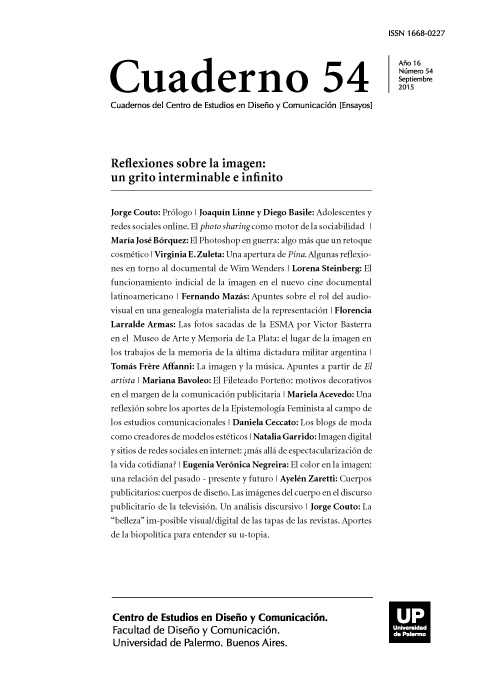Apuntes sobre el rol del audiovisual en una genealogía materialista de la representación
Abstract
The central problem of the paper is the shaping of visual sign language in
the context of an imaginary dialogue between the perspectives that Pier Paolo Pasolini
and Gilles Deleuze, in his writings Heretical Empiricism and the time-image respectively,
developed on this topic.
First, what the French philosopher claimed on Pasolini ‘s theory is that (unlike Metz, Eco,
Garroni and other contemporary semioticians in the early ‘60s, who have attacked the author accusing him of lack of professionalism and semiotics ingenuity) the narrative is not
a manifest data of cinematographic images, but was historically acquired. This is precisely
because both authors (and this is perhaps its central theoretical coincidence) consider that
the film image can not be assimilated or reduced to a statement .
That’s why, given that advances in technology and the proliferation of formats, genres,
production and distribution channels propose increasingly numerous and deep analytical
challenges, to retrieve and to analyze fully the implications of this theoretical perspective,
can generate a large contribution to contemporary studies of audiovisual languages.
References
Duflot, J. Conversaciones con Pier Paolo Pasolini. Traducción: Joaquín Jordá. Barcelona: Editorial Anagrama, 1970. Pág. 46.
Foucault, M. ¿What is an author? (1969) en Adams, H. y Searle, L. (1966). Critical Theory since 1965. Tallahassee: Florida State UP, pp. 138-48.
Green, N. (1990). Pier Paolo Pasolini: Cinema as Heresy. Princeton: Princeton University Press.
Mariniello, S. (1999). Pier Paolo Pasolini. España: Ediciones Cátedra S.A. p. 320. pp. 54-55.
Pasolini, P. P. (1997). Cartas Luteranas. Traducido por Torrell, J; Giménez Merino, A. y Capella, J, R. Madrid: Editorial Trotta, p. 12. (1993). Escritos Corsarios. Traducido por Silvia Manteiga, Santiago de Compostela: Edicions Positivas, p. 119. Acto seguido Pasolini aclara que su tesis no es completamente herética o heterodoxa sino que en el Manifiesto comunista de Marx ya se mencionaba un genocidio cultural cometido por la burguesía contra poblaciones subproletarias y coloniales.
(1982a). Empirismo Hereje. Traducido por Miguel Serras Pereira. Lisboa: Assirio e Alvim.
pp. 127-8.
(1982b). Hipoteses de Laboratorio en Empirismo hereje. Traducido por Miguel Serras Pereira.
Lisboa: Assirio e Alvim. p. 58.
(1982c). O fim da Vanguarda, en Empirismo hereje. Traducido por Miguel Serras Pereira.
Lisboa: Assirio e Alvim, p. 100.
Pasolini, Entrevista con Michel Maingois, Zoom (Octubre 1974), pág. 24, citada por Green, N. (1990), p. 129.
Pasolini, Entrevista con Gian Piero Brunetta, Cahiers du Cinema. N° 212 (May 1969), p.
, citado en Green, N. (1990). Pier Paolo Pasolini: Cinema as Heresy. Princeton: Princeton University Press, p. 87.
Rohdie, S. Neo-Realism and Pasolini: the desire for reality. En Baranski, Z. G. (ed.) (1999).
Pasolini Old and New. Dublin: Foundation for Italian Studies: University College Dublin.
pp. 164-179.
Stack, O. (1969). Pasolini on Pasolini. Bloomington: Indiana University Press. pp. 105-06.
Los autores/as que publiquen en esta revista ceden los derechos de autor y de publicación a "Cuadernos del Centro de Estudios de Diseño y Comunicación", Aceptando el registro de su trabajo bajo una licencia de atribución de Creative Commons, que permite a terceros utilizar lo publicado siempre que de el crédito pertinente a los autores y a esta revista.


